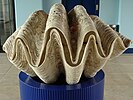The Bivalvia comprise a class of marine and freshwater molluscs that have laterally compressed bodies enclosed by a shell consisting of two hinged parts. Bivalves include clams, oysters, cockles, mussels, scallops, and numerous other families that live in saltwater or in freshwater. The majority are filter feeders. Most bivalves bury themselves in sediment, where they are relatively safe from predation, though some others lie on the sea floor or attach themselves to rocks or other hard surfaces. A bivalve's shell (giant clam shell pictured) is composed of calcium carbonate, and consists of two, usually similar, parts called valves, which can open and close without becoming disarticulated. Adult shell sizes of bivalves vary from fractions of a millimetre to over a metre in length, but the majority of species do not exceed 10 cm (4 in). Bivalves have long been a part of the diet of coastal human populations, and pearl oysters are the most common source of natural pearls. Bivalves first appear in the fossil record more than 500 million years ago. The total number of living species is approximately 9,200. (Full article...)
Recently featured: Roderic Dallas – Doc Adams – Resurrectionists in the United Kingdom
